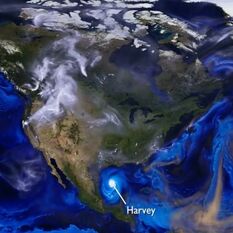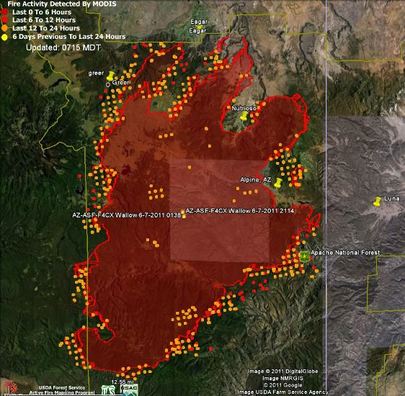 You don't have to be a journalism professor to see that national media coverage of hurricanes and wildfires are different in both style and duration. You see it most dramatically when there are a small number of active fires with large impacts happening at about the same time as a hurricane hitting the US coastline. It's even more acute when an incident like the Camp Fire is responsible for more lives lost and perhaps just as much property damage as a typical hurricane. Or the Woolsey Fire where there are deaths and 200,000 residents evacuated. People wonder why the national media is not sending their top anchors to report continuously from the fire lines like they do from the beaches during a hurricane.
1 Comment
 The Wallow Fire started fast and got big faster. On the third day, it went from about 6,700 acres to 40,000 and over the next seven days, it consumed the following acreage:
Upon arriving, I was assigned to lead the Media Group and it was not soon after that it became evident we were not functioning well. Information was too detailed, too fluid, too much, and too frequent for consistency between individual PIOs (and some of those PIOs were, by necessity, forced into roles beyond their capacity). After hearing complaints from both PIOs and media, we held an impromptu press briefing. We then committed to twice-daily briefings and things seemed to settle down a bit for the media, but not for us. What follows are some thoughts on media briefings and large incident issues in general. Much of this post is based off of a piece I wrote soon after leaving the incident, so some of you may have seen that earlier version. Media briefings are not something we do every day. Sure, crisis communicators and PIOs often do interviews, but a full-blown live media briefing for a high-visibility incident seldom comes around. I've had the luck--or misfortune--of doing media briefings on four incidents during my career. Some were bigger than others and one was more emotional than the rest, but the common elements are multiple and varied media outlets, live broadcasts, long-term and complex incidents, and regional or national (and international) coverage.
Media briefings are perhaps the most intense thing we can do as PIOs/crisis communicators. Not only are we representing all the responders and speaking to all of the public affected, but because of the high visibility, many others are watching and our reputation--perhaps our career--might be influenced by a single exchange. Because of that dynamic, you can look at media briefings as the most personally stressful communications chore. If you are speaking about fatalities, it amps things up even more. Since the idea of this blog popped into my head, I've been thinking about a post on media briefings. I started writing a few times, but those attempts were ultimately frustrating. As I worked through the process, I came to realize I couldn't build a post around an academic bent or just jot down a basic How-To. No, in order to honestly convey the lessons I learned, it had to be more personal. So please bear with me. As of now, I plan to break the topic up into three posts (maybe four) that will mirror the chronology of my career through the Rodeo-Chedeski, Wallow, and Yarnell Hill fires. (The Eagle Creek Fire will make an occasional guest appearance.) This first one will be the most personal and deal with learning and persevering through failure, the second will cover mostly positive lessons learned, and the third will be about the unique stresses fatalities bring. Last week, the Salt Lake Tribune cut their newsroom staff from 90 to 56 and announced they will stop publishing statewide news sections and reduce content in other sections. The Denver Post announced they will drop 30 positions. The Boston Herald recently went from 240 employees to 175. The reduction of reporters is a trend that has been going on since the digital became ascendant.
In 2000, there were 65,900 reporters in the United States, but by 2015, there were 45,800 reporters and their salaries had cumulatively diminished over those years to fall behind the inflation rate. Take broadcast reporters out of the equation, and pay for reporters is below the national average. The decline in job numbers fell mostly on the newspaper side, but local radio also took a big hit. The PIO community has made great strides over the last 10-15 years by expanding how we think of our audience to include Spanish speakers. It is now routine to have updates and social media posts translated into Spanish and you can usually find a Spanish-speaking PIO on most large incidents. There is support for this from both the greater organizations and the response community. (And kudos to those who have pioneered sign language at public meetings and other Info events.)
 Welcome to the Anchor Point Blog, by me, Jim Whittington, of Whittington & Associates, LLC which is on www.incident-service.com. Whew. There will be regular guest bloggers too. I bet you can guess their names. This blog will discuss IMT dynamics, leadership, incident information, crisis communications, risk communications, media issues on incidents, NWCG and FEMA training, emergency management, academia, wildland fire, and other directly or tangentially related topics. There might even be posts that are not related at all. Here’s some other admin stuff:
_____ Jim |
Occasional thoughts on incident response, crisis communications, wildland fire, and other topics.
Docendo disco, scribendo cogito. Blog DOB: 4/26/2018Copyright © Jim Whittington, 2019. Archives
August 2019
Categories
All
|
 RSS Feed
RSS Feed